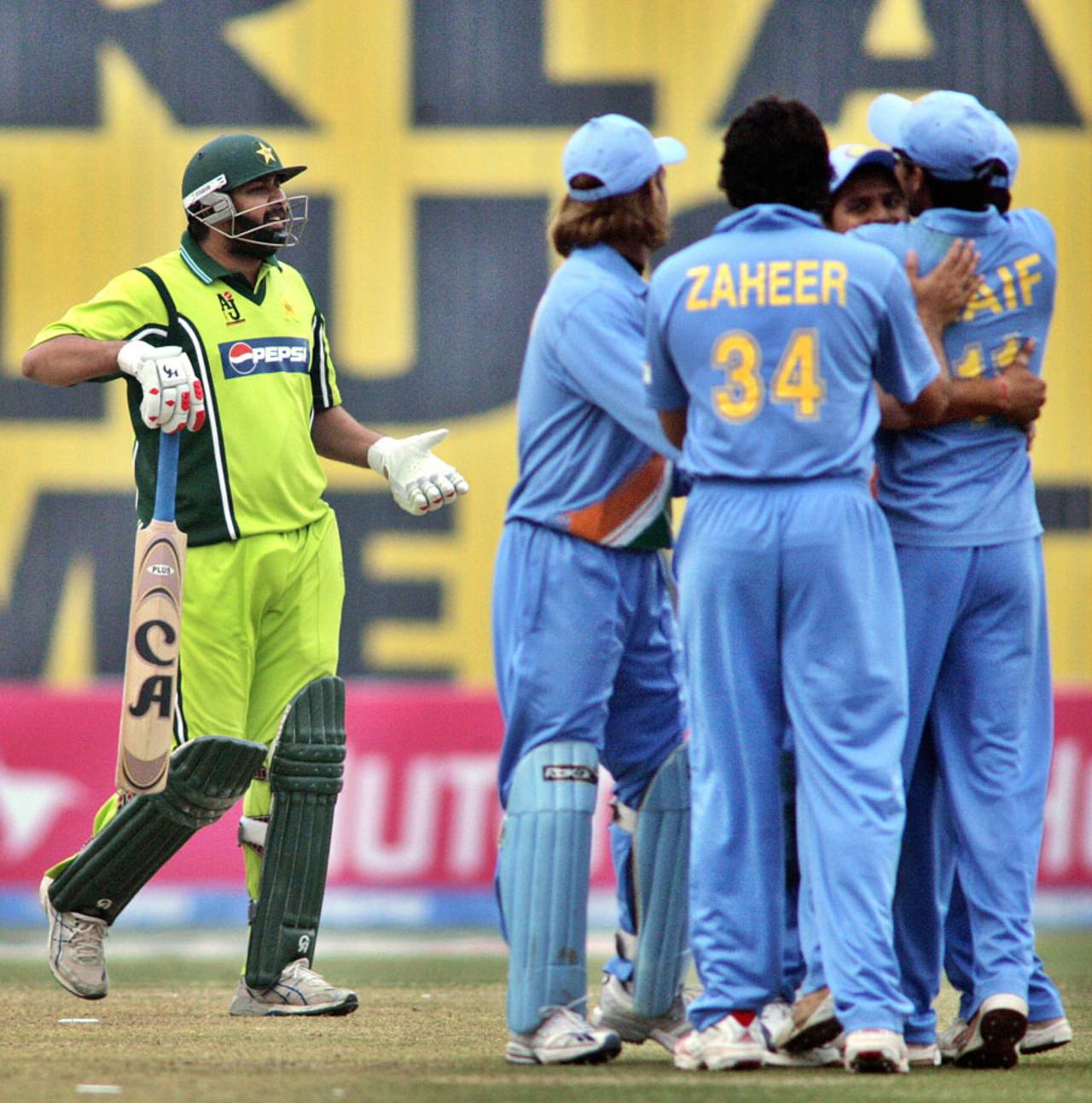'I am not able to comprehend this law'
Before Ben Stokes, six batsmen had already run into issues with the obstructing the field law in international cricket
Anuj Vignesh
06-Sep-2015

Inzamam-ul-Haq was bemused after being given out for obstructing the field • AFP
The fifth Test between England and South Africa at The Oval in 1951 featured the first instance of a batsman being given out for "obstructing the field" in international cricket. Chasing 163 for victory, England began solidly, with the openers Len Hutton and Frank Lawson sharing a 53-run stand. However, a freak wicket threatened to derail the hosts' innings. A rising delivery from Athol Rowan hit Hutton on his gloves, and as the batsman later explained, the ball appeared to be heading onwards to the stumps. In that split second, Hutton never thought about the wicketkeeper making a catch, and instead flicked at the ball with the bat. The ball neither trickled on to the stumps, nor into the South Africa keeper Russell Endean's gloves. While Hutton had not directly obstructed Endean, by willfully raising his bat, he had prevented the keeper from getting to the ball. Quite rightly, the umpire Dai Davies signalled Hutton out, bringing an unsatisfactory end to his 100th Test innings.
A Graham Gooch century in Karachi in 1987 lifted England to 263, and despite some lacklustre fielding from the visitors, they had all but sealed victory going into the final over of the second ODI against Pakistan. Ramiz Raja, though, still had something to play for. Stuck on 98, he attempted taking two off the last ball of the innings, but was adjudged by the umpires to have obstructed the field while taking the second run. It denied Ramiz his second ODI century, and completed a hat-trick of strange dismissals for him that year against England: he was run out while walking off after being caught off a no-ball - he did not hear the umpire's call - in Perth, and was run out without facing a ball at The Oval.
Mohinder Amarnath became the first and, till date, only Indian to be given out obstructing the field, during the 1989 Nehru Cup clash against Sri Lanka in Ahmedabad. After opting to bat, India were motoring along without much trouble thanks to Navjot Sidhu's assured fifty, and his 61-run stand for the third wicket with Amarnath. However, with the score at 95 for 2, the partnership came to an unexpected end when Sidhu sent Amarnath back during an attempted run. Amarnath, who was on strike, kicked the ball away as Ravi Ratnayeke, the bowler, and Arjuna Ranatunga, the fielder, converged towards it. The umpire Khizar Hayat had to rule Amarnath out. Amarnath had incidentally also been dismissed for handling the ball during a World Series Cup game against Australia in 1985-86.
Inzamam-ul-Haq is no stranger to comic dismissals, but the manner in which he got out against India in Peshawar, in 2006, is unlikely to have brought him or his team-mates any laughs. With Pakistan chasing a revised target of 305, Inzamam, batting on 16, stepped a couple of yards out of his crease and pushed a Sreesanth delivery to mid-off. Inzamam thought that was the end of it, but Suresh Raina picked up the ball and threw at the stumps with Inzamam still out of his crease. Inzamam presented a high elbow and straight bat, a pretty picture under normal circumstances. But in this situation, the Indians appealed, and after consulting with each other, the umpires Asad Rauf and Simon Taufel ruled that Inzamam's solid block was indeed a willful obstruction. Inzamam was livid. "If one surveyed the laws of cricket, the umpires' decision was certainly according to the rules but, somehow, this law is something that I am not able to comprehend," he wrote in his column for The News. "In my role as the Pakistan captain, I would say that the appeal from the Indian fielders was against the spirit of cricket. Certainly, there are several modes in which a batsman can be declared out, but many of them are not in the spirit of the game."
Mohammad Hafeez lasted all of one ball against South Africa in Durban, in 2013, and his dismissal raised more talking points about Law 37, which relates to obstructing the field. In the second over of Pakistan's chase, Hafeez was adjudged to have readjusted his line of running while coming back for a second to the non-striker's end. Hafeez was not pleased, but could do nothing to reverse the umpires' decision. His captain, Misbah-ul-Haq, later offered an explanation: "He was just running in line, trying to shorten the length. He wasn't looking behind when AB de Villiers threw the ball. Hafeez suggested it wasn't intentional because he didn't know where the ball was thrown from. But it's not in our hands, as it's the umpires' call."
Law 37 states that for a batsman to be given out obstructing the field, he must "obstruct or distract the fielding side by word or action". It wasn't clear if that is what Anwar Ali was intending against South Africa in November 2013, when he tried to sneak a bye off Dale Steyn. The ball ran through to the wicketkeeper Quinton de Kock, who quickly released it towards the non-striker's end, only to find Anwar's shoulder. Anwar had changed his line of running slightly. Had he seen the throw coming in in his peripheral vision? We'll never know, but the umpires deemed it to be out.
Anuj Vignesh is a sub-editor at ESPNcricinfo